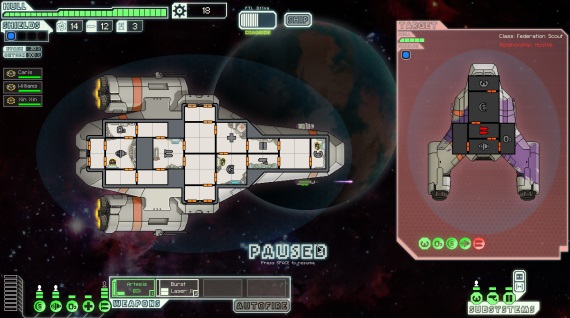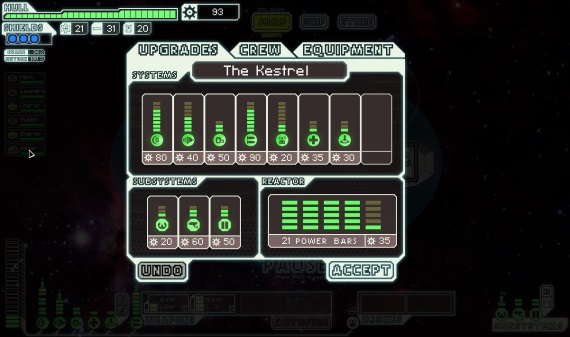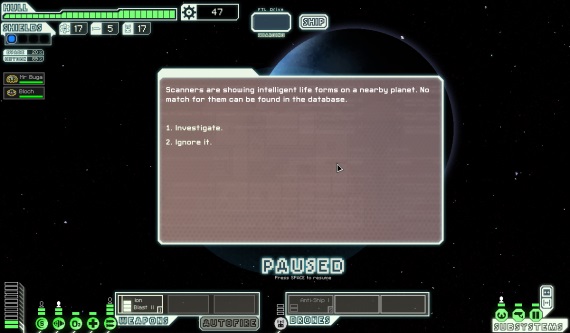18 Apr
I actually quite like the simplified and yet informative graphics used in this game.
FTL is a Kickstarter-funded indie game that I considered backing for a while. I ultimately didn’t but I did buy it recently when it went on sale on Steam. After playing it for a short time I’m glad I didn’t back it. As advertised, this is a rogue-like and I must say not a very deep one at that. I’ve never been a fan of rogue-likes and playing this game reminded why this is so. Some comments:
- The premise here is that you control a single ship that is part of a Federation. Your mission is to return home to warn about the invasion of the Rebels. This involves jumping from system to system and from sector to sector, all the while keeping just one step ahead of the Rebel fleet. It’s a simple mechanic to limit your ability to fully explore each sector and to give the game a sense of tension.
- What’s cool about this game is that each compartment of your small ship is detailed and does a specific job. Each crew member can be assigned to move to a room. So a crew member assigned to the Weapons room will help your weapons recharge faster, the extent of which depends on his or her skills. Some stations don’t require crews and can’t be crewed. For example, there’s no need to assign crew members to the life support system or the sensors room. But all rooms can take damage and be knocked out so you may need to send someone to a room to repair it or put out the fire there.
As you may be able to tell, upgrading power is critical since power goes into every other system.
- As expected, there’s a nice ship customization system in here. Ships can be equipped with a variety of weapons and you can even install a drone control room to deploy drones or a teleporter room to transport crew members to board an enemy ship. You pay for upgrades and buy parts from merchants using scrap. The constraint in installing all manner of systems is power since everything requires energy.
- Combat uses a pausable real-time system. You manually target each weapon system on each section of an enemy ship and you can order your crew members to move around your ship as you like. You’ll want them manning the right stations, to put out fires and repair damage and even fight off invaders who have boarded your ship. One interesting design choice here in that shields recharge relatively fast, usually faster than your weapons recharge, and each layer of shield usually absorbs one shot, regardless of the damage per shot. So a key part of combat is timing your weapons to all fire at the same time to take down the enemy’s shields and go on to damage systems.
- What I intensely dislike is that exploration consists of nothing more than a series of random encounters. Sometimes having crew of a specific alien race or having a specific piece of equipment on board your ship gives you a special way of resolving an encounter but by far most encounters consist of a fight with an enemy ship. Worse, encounters are not related to each other at all. You can be friends with an Engi ship in one part of the sector and fight them at another part. As you might expect, this makes the game highly random. You may luck into a really good weapon early on or you may come across an enemy who boards you with powerful warriors while you have absolutely no defense against them. It’s all up to chance. I know that this is part of what makes rogue-likes fun for something, but I’ve discovered that the combination of chance and punishing difficulty is not to my taste at all.
So while I can definitely see why some people might like this game, I just can’t find myself having fun playing it. If it were only a little deeper with the encounters, gave the player a bit more control over encounters maybe I could put up with the difficulty and the enforced Ironman mode. But as it is, it’s just not my cup of tea. Sorry.
I actually like text adventures, but the ones here are just too simple.
Written on April 18 2013 and is filed under PC Games.
You can follow any responses to this entry through the RSS 2.0 feed.
You can leave a response, or trackback from your own site.



Leave a Reply